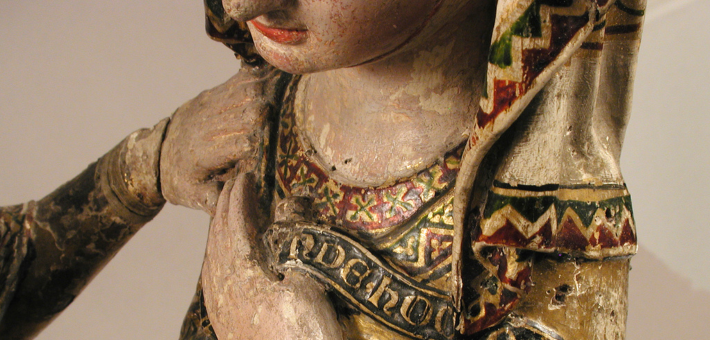Commentary on Luke 1:39-45 [46-55]
Many will remember Roots, Alex Haley’s 1976 phenomenal book that was a New York Times bestseller for 46 weeks. We will also remember the must-see television miniseries thereafter, as 130 million people tuned in to follow the saga of an American family that began with a 17-year-old Gambian boy named Kunta Kente.
That book stirred up a thirst for belonging that has not abated. Indeed, the legacy of Roots is that many families even now are eager to find their place, to connect to the past, and to trace their roots—via the National Archives or the Freedmen’s Bureau or DNA kits like 23andMe, FamilyTreeDNA, and Ancestry DNA.
As we move into the Advent season, could not the earliest chapters of the Lukan Gospel be our own collective story of Roots—that is, an attempt to trace the roots of Jesus’ prophetic movement? Could not those chapters, especially Luke 1:39–45 (46–55) among them, provide us with a sense of belonging, a sense of identity, as we celebrate with expectancy the arrival of God’s intervention in human society even today?
God knows we need some roots. The strains and stresses of Christianity visible in our society today seem a far cry from the virtuous settings in which the prophetic lives of John and Jesus found their footing. Market mentalities seem to control our vision of this important season. Incessant news feeds remind us of the trauma that church members, especially the young ones, have been forced to face because of high-profile clergy sex-abuse scandals. Furthermore, many Christians have embraced an ultranationalist brand of Christianity—one in which religious zealotry trumps constitutional law. So, yes, God knows we need some roots. And Advent reminds us of at least three of them.
One root is the celebration of the assurance of God’s promises in others. The Advent story could have been told solely to accentuate the individual statements of praise by Elizabeth and Mary—to tell us what God had done (pepoiēken, 1:25) just for Elizabeth or to tell us what God did (epoiēsen, 1:49) just for Mary.
Instead, the Advent story brings the two women together (1:39–45), and we see their mutual recognition of what God was doing in the other’s life. Mary greets while Elizabeth blesses. Elizabeth’s “the fruit of your [Mary’s] womb” aligns well with “the child of my [Elizabeth’s] womb.” Huddled together in Judah’s hills, both can visibly see in each other’s pregnancy the assurance of the promises of God in the other.
This only happened, though, because one of the women (Mary) went on a journey to see the other (Elizabeth). Would we not be rescued from the narcissistic self-interest of our own quotidian affairs if we were placed in the proximity of others? Would we not see the brimming humanity and divinity in all if we did not isolate ourselves through the trappings of gated communities, outmoded notions of what constitutes a family, and retrograde immigration policies? Who is willing to take Mary’s spot today—to travel, to make the journey to see what God is doing in someone else’s life?
A second root of which we are reminded at Advent is the constancy of God’s mercy. While many see a great reversal in Mary’s Magnificat, and rightfully so, let us not miss an emphasis on the unchanging nature of God’s mercy. As Mary’s song moves from a personal paean of praise to a broader statement on what God had done in the lives of Mary’s people, it emphasizes the constancy of God’s mercy. Such phrases as “generation after generation” (1:50) and “forever” (1:55) suggest that Mary’s song is not limited temporally to the past nor the present. Whatever God is doing, God is capable of doing it for a long time—forever.
That root of the constancy of God’s mercy is sorely needed. Our world is marked by change: natural changes, like the ebb and flow of the tides; technological changes, like the arrival of phones that are smart, cars that are electric, social media platforms that are plentiful, and Generative AI that is here to stay. Still, though, other changes—declining health, turns of fortune, the loss of a loved one, and even the ups and downs of political election cycles—create anxiety and weigh heavily upon us. In the face of such anxiety-producing change, Advent reminds us of what is constant—the mercy of God.
A third root of which we are reminded at Advent is the contagion of praise. In a biological sense, we speak of “contagion” in a negative way, as something, like an active form of tuberculosis, to be avoided. In a psychological sense, though, the word “contagion” may be positive. Indeed, in the Advent story of the Lukan Gospel, we see that the idea of contagion can be a positive factor in the spreading of vitality and hope.
Luke has a contagion of praise. Woven throughout the warp and woof of Luke’s early chapters (and the whole Gospel, for that matter) is a theme on the praise of God. When Elizabeth later gives birth, for example, her neighbors and relatives rejoice with her that God has shown great mercy to her (1:57). Then, Zechariah blesses God for remembering God’s covenant, sworn to Abraham, for what would be all of Israel (1:68–72).
Then, a heavenly host will praise God for the birth of a Savior (2:14–15). Then, the contagion of praise will move from angels to the shepherds who glorify God for all they have heard and seen (2:20). Simeon will praise God for the child Jesus (2:27–28), and so will prayerful Anna (2:38).
Of course, all of this contagion of praise starts with two women: Elizabeth, who praises God for what God has done (1:25), and Mary, who praises God for what the Mighty One did (1:49) in her life.
With whom will the contagion of praise begin in our own communities? Why wait for someone else to start it?


December 22, 2024